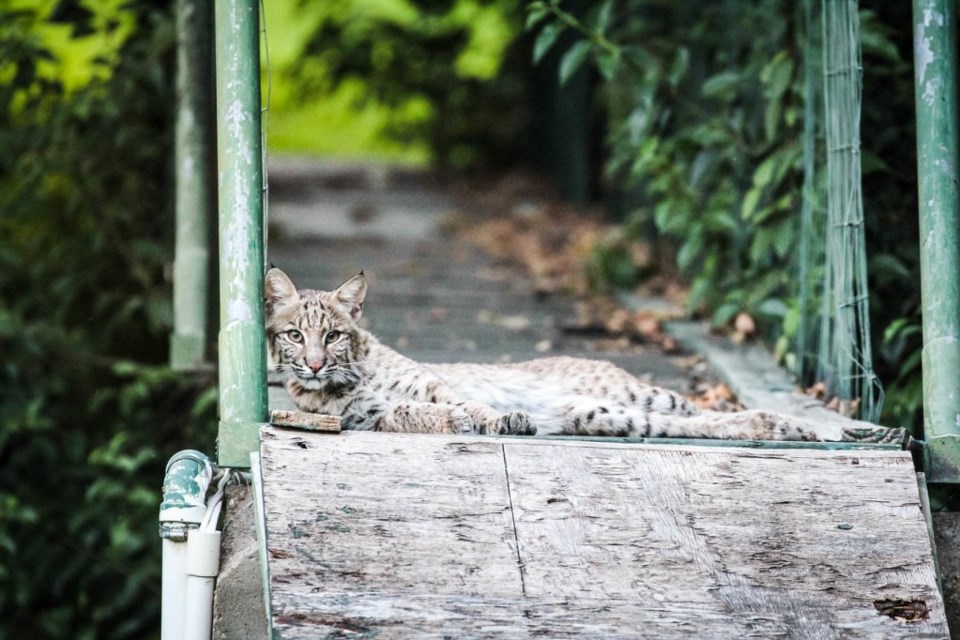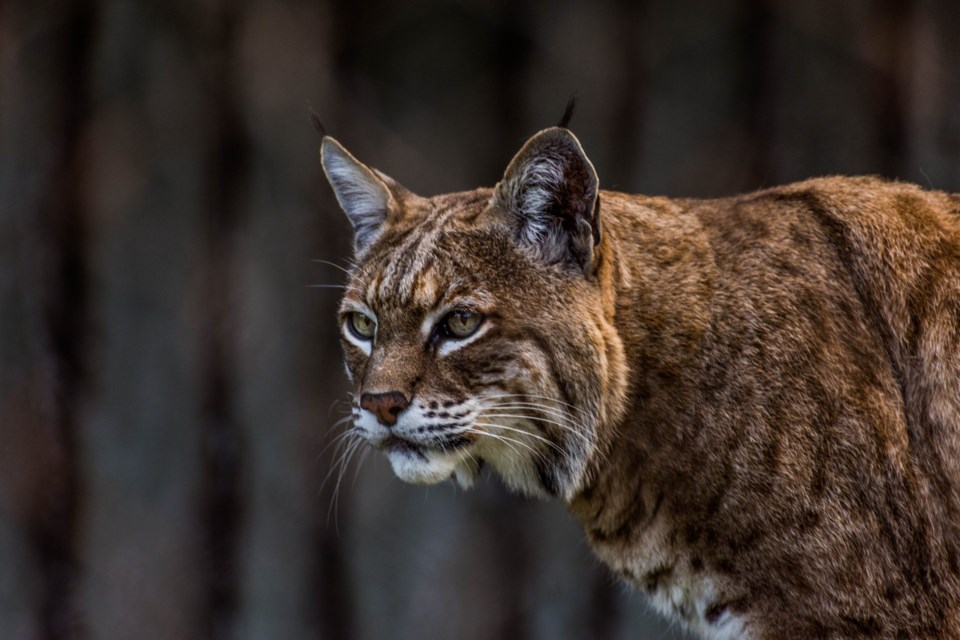Bonnie Hale saw a bobcat with a rabbit in its mouth appear from the bushes and go into a storm drain near her client's home in Plano early one morning. As a pet detective based in Grapevine, Hale helps people find their lost furry friends all across North Texas. But what she didn't realize until that morning was bobcats had figured out that traveling through storm drain systems keeps them safe from humans as they sneak into yards to look for prey.
Well played, bobcats.
Bobcats have unintentionally terrorized North Texans for years as the suburbs continue to move into their territory. Stories of lap dogs and outdoor cats being killed and eaten by them circulate the media every year. Some opinions on the frequency of bobcat attacks differ, but these wild animals are a very common concern for pet owners in the area. And the intelligence of bobcats, as exhibited in their secret underground pathways, makes it all the more difficult to keep our pets safe from them.
Not only do their smarts help, but these carnivorous wild cats weigh anywhere from 11-30 pounds, according to National Geographic. They also measure 26-41 inches tall, with a tail length of 4-7 inches. To put this in perspective, bobcats can be roughly twice the size of your average housecat.
So what can you do to keep your beloved pets safe from these incredible predators? Here are some bobcat facts and tips from Hale.
“The truth is, most people think, 'Oh, [my pet has] been going outside for years. It's not going to happen.' Until it does,” Hale says. “All the warnings in the world [and] all the techniques I have not seen save very many pets' lives because people don't take action until something bad happens, at which point it's too late.”
Will a Bobcat Attack a Dog?
Yes. Bobcats do attack dogs and dogs under 30 pounds are most at risk. The best way to protect your small dog or pet from a bobcat attack is to stay with them. So, if your dog needs to go to the potty in the yard, go with them. Bonnie Hale, a pet detective based in Grapevine, gives additional advice below.
How Common Are Bobcat Attacks in North Texas?
“Extremely common,” Hale says. “It’s really a year-round problem.”
However, Hale notes that she sees a spike in bobcat predation during whelping or breeding season. Nationwide, bobcat young can be born anywhere from March-July, according to Wildlife Damage Management.
Of course, bobcats don’t come into your yard solely because of pets. They come to look for prey — rabbits, rats and snakes, Hale says. But as they have become more comfortable hunting in closer proximity to humans, they often stumble upon our pets.
Through her work, Hale has come across hundreds of cases where a bobcat killed someone’s pet.

What Size Pets Are Most at Risk?
It’s NOT a good idea to fatten up your pet so they can take on bobcats. But the bigger the pet, the safer they are. Hale says the most at-risk size pets are those under 30 pounds, and especially under 20 pounds.
If you have only a big dog, you really don’t have anything to worry about. While a bobcat could technically still attack and seriously hurt an animal over 30 pounds, it likely won’t.
“There’s too much of a size disparity,” Hale says. “They are looking for a meal, not a fight.”
While your lovable golden retriever may not seem like much of a fighter, if a bobcat squared up, it would fight back. And bobcats can’t afford a fight. Unlike injured pets, who we take to the vet for antibiotic shots and treatment, a bobcat is on its own and could easily die from an infected wound.

How Can You Prevent Bobcat Attacks?
Like The Jackson 5 once said, “I’ll be there.” And that’s actually something you can do to keep your small dog safe from a bobcat.
“The best thing you can do is to be there with your pet,” Hale says. “[Bobcat attacks] almost never happen when humans are present.”
Hale’s advice is that if you have a small dog, you need to go with it outside for bathroom breaks. This advice mostly applies to nighttime when bobcats are most active. Some scientists consider bobcats to be nocturnal (most active at night), and others consider them crepuscular (most active at dawn and dusk). Either way, when it’s dark out, the bobcats may be out, too.
As far as protecting your indoor/outdoor cat, Hale says she sees a spike in cases of formerly successful indoor and outdoor cats who are suddenly killed by a bobcat when they reach about 10-12 years old. Just like humans, cats age. And with age comes a decrease in agility, hearing, vision, along with slower reaction times.
Hale ran into this problem with her own cat. She started bringing her cat inside at night when it got older rather than letting it run around outside. In true cat fashion, it was super pissed. Naturally, Hale had to come up with a compromise to keep her cat from destroying her home in protest throughout the night.
So if your older cat still needs some outdoor time, try to only let it outside during the day. If it needs some outdoor time at night, just make sure you give it some good hiding spots. Hale says she also sees a spike in cases of formerly successful indoor/outdoor cats suddenly killed by a bobcat when someone has had things like junk cars, sheds or decks in their yard that makes the perfect cat hideouts and decide to remove them.
“The cat can get to safety in a blink of an eye if they have those present,” Hale says. “But somebody will come in and suddenly decide, ‘Okay, we're going to rip all this crappy stuff out.’ And now the cat has no hiding places.”
You can even DIY your own “cat bunker,” as Hale calls them, out of cinderblocks. Hale says you would need about 10 cinderblocks to create an opening just big enough for you to stick your fist into but allow your cat to hide inside.
One way to prevent bobcats that apply to both cats and dogs is to keep your pet in a well-fenced yard. While bobcats can pretty much scale a fence of any height, “the taller the fence, the better the protection,” Hale says. They would rather jump a lower fence so that they can see what’s in it first to ensure it’s safe.
Along with fencing, Hale says preventing rats from living near your home is another way to keep bobcats away since rodents are a huge part of their diet. And if you happen to have a large dog in addition to a small dog(s) or cat(s), that’s protection in itself. Their size will typically scare off a bobcat.

What Should You Do if You See a Bobcat Attacking Your Pet?
Hale emphasizes that the decision to intervene or not needs to be a personal one. You are the only one who can ultimately decide if you want to risk injury to save your pet. It’s hard to know what one would do in a dangerous situation. You may think you would immediately intervene, but your fight-or-flight response could cause you to freeze up. One option is to start yelling and running in the bobcat’s direction or banging pots together or even sounding an air horn. She says just do anything to make as much noise as possible to scare it away.
Hale has seen pets survive bobcat attacks when their owner steps in fast enough. Typically, they get injured enough to need vet care, but some make it out alive just because of human intervention.
If a bobcat bites or injures you, it is critical that you not only take your pet to the vet but yourself to the hospital to ensure you don’t get an infection. Bobcats are wild animals, so use caution and care. When in doubt, stay with your pet.
Wondering what other animals to look out for in Collin County and North Texas? Click here for our list of 5 most dangerous critters.
This article was originally published on May 5, 2021.




